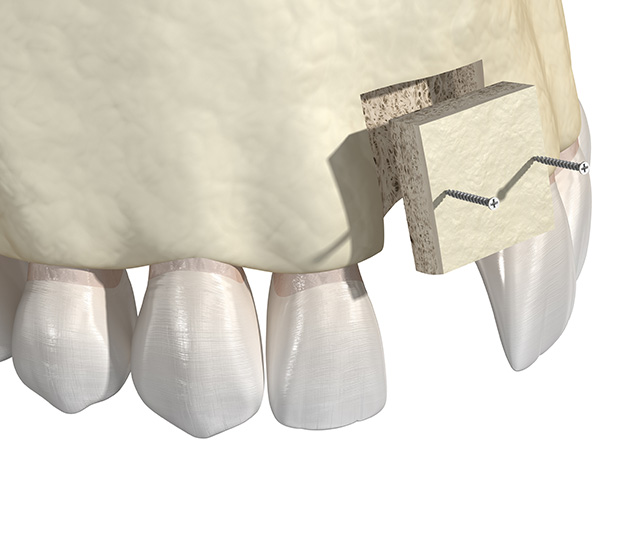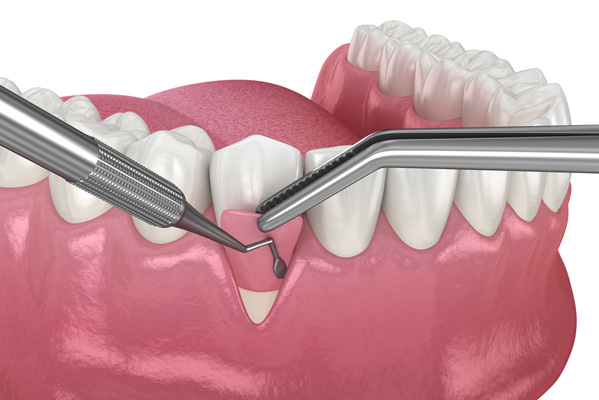Bone GraftingThe Woodlands, TX
Bone grafting is a surgical procedure in which a surgeon transplants bone tissue. There are several reasons a person may require bone grafting. In the case of periodontics, bone grafting can often help repair or rebuild damaged teeth.
Bone grafting is available at Montgomery County Periodontal Associates in The Woodlands and the surrounding area. Many patients find that this procedure restores both the appearance and the function of the mouth. Call us today at 281-404-7548 to schedule an appointment or learn more about our services.
Understanding Bone Grafting
More than just a matter of aesthetics, missing and deteriorating teeth can also significantly impact the functionality of the overall oral cavity. By promoting new bone growth, bone grafting can help replace missing bones. In this procedure, Dr. Mason makes a small incision over the bone defect before shaping and inserting the bone graft into and around the area. He will then hold it in place with pins, plates, or screws.
Jawbone deterioration and loss may occur due to several reasons. These include, but are not limited to:
- Congenital disabilities
- Facial trauma
- Malocclusion
- Oral pathology
- Periodontal diseases
- Sinus deficiencies
Furthermore, missing teeth may cause the jawbone to resorb (or atrophy) over time. This remaining bone may be insufficient either in quantity or quality to place dental implants. Additionally, bone loss may also cause the facial appearance to sag, complicate future dental procedures, expand the sinuses, and impede a patient's ability to chew and speak.
Check out what others are saying about our Bone Grafting services on Yelp: Bone Grafting The Woodlands
Reasons for Bone Grafting
Bone grafting procedures can range from minor (such as when performed to fill an empty bone socket) or major (such as when performed to correct any jaw irregularities). In any case, there are four main reasons for bone grafting: nerve repositioning, ridge augmentation, sinus lift, and socket preservation.
Nerve Repositioning
Placing dental implants often necessitates repositioning the inferior alveolar nerve. In a nerve repositioning procedure, Dr. Mason exposes the nerve and vessel canal by removing an outer section of the cheek on the side of the lower jawbone. Then, he will isolate the nerve and vessel bundle in that area, pull it out slightly to the side, and place the implants. The incision site will be refilled with the bone graft material before it is stitched back together.
Ridge Augmentation
Dr. Mason can also restore the alveolar ridge bone with bone grafting. This procedure is typically performed to recontour the gums and the jaw. This usually occurs after a tooth extraction, as tooth extractions tend to lead to the loss of the natural contour and create an empty socket in the alveolar ridge bone. While this socket will usually heal on its own, it may also break and deteriorate.
Sinus Lift
Occasionally, the sinus floor must be raised to allow for new bone formation. This procedure is known as sinus augmentation surgery or sinus lift surgery, and it is generally only necessary when the sinus wall is insufficient for dental implant placement. This generally only occurs due to injury or periodontal disease.
Socket Preservation
Teeth are held in place by bones called sockets. These sockets may sometimes become damaged by infection or disease following a tooth extracting, eventually causing a deformity of the jaw. Any jaw deformity may make future restorative dentistry treatments difficult or impossible. Socket preservation can prevent any bone loss by immediately filling the socket with graft material following extraction. Dr. Mason will then cover the socket with artificial gum, membrane, or tissue to expedite the healing process.
Types of Bone Grafting
Bone graft material can come either from the patient or a donor. There are three main types of bone grafts: autogenous bone grafts, allogenic bone grafts, and xenogenic bone grafts. Each type of bone graft has its own unique set of advantages and disadvantages.
Also known as autografts, autogenous bone grafts take bone from the patient's body (usually from the chin, jaw, hip, lower leg bone, or skull). Allogenic bone grafts, or allografts, harvest dead bone from a cadaver and process it via a freeze-dry method.
Xenogenic bone grafts, also called xenografts, take bone from another species (usually cows). Samples from xenografts are subject to extremely high temperatures to minimize the risk of rejection and contamination.
Autografts are the only type of bone graft that can produce new bone on their own. Consequently, bone regeneration after allografts or xenografts may take longer. Still, some patients prefer that they do not require a separate procedure to harvest bone, as autografts do.
Call Us Today
Deteriorating teeth are a matter of both oral health and aesthetics. We at Montgomery County Periodontal Associates can help. Call us today at 281-404-7548 to schedule an appointment or learn more about our services.
Frequently Asked Questions
Can my body reject bone grafting?
It is a rare possibility. Our qualified team will work closely with you to ensure your safety throughout the entire process. You are our number one priority. Additionally, if you have any questions or concerns, we will be happy to answer them throughout the process.
Are there any substitutes for bone grafting?
Several synthetic materials are available for bone grafts, including bone morphogenetic composites, demineralized bone matrix (DBM), demineralized freeze-dried bone allograft (DFDBA), and graft composites.
Does everybody require bone grafting for dental implants?
No, not everyone needs bone grafting before dental implants. However, it may be useful for patients with jawbones that are either too soft or too thin for placement. Dr. Mason can help determine the best course of action for you during a one-on-one consultation.
How can I prepare for bone grafting?
Depending on your specific procedure, you may need to fast to avoid any potential complications with anesthesia. We will provide you with any specific information you need. However, in most cases, we will need to perform a physical examination and conduct a comprehensive overview of your complete medical history well in advance.
How long does it take to recover from bone grafting?
The answer varies depending on the patient and the procedure. However, the average recovery time is anywhere from a few months to over a year. We will make sure you are well-prepared for your procedure, so you know exactly what to expect.
Contact Us
Montgomery County Periodontal Associates is located at 1001 Medical Plaza Dr Ste 110 The Woodlands, TX 77380.





